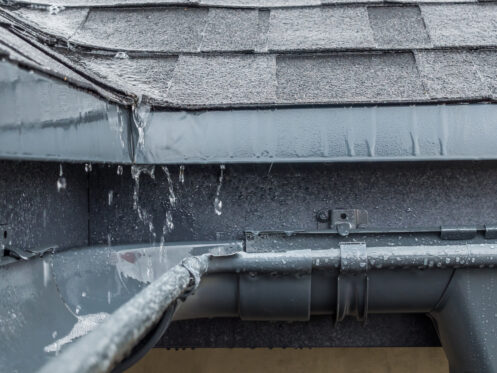Spring in Charlotte brings a mix of sunshine, rain, and unpredictable storms, which means your roof needs to be in top shape. The winter months can result in wear and tear, and if you don’t catch small issues early, they can turn into expensive repairs. Loose shingles, clogged gutters, and unnoticed leaks can put your home at risk when heavy rains roll in.
From now on, you won’t have to deal with as much trouble by getting ready now. That’s why Blue Fox Roofing & Renovations in Charlotte, NC recommends taking the time to check for any potential problems and get your roof ready for the season ahead.
Check for Loose or Missing Shingles
All year long, your roof takes a beating, but winter can be especially tough. Cold temperatures, heavy rains, and strong winds can loosen or dislodge shingles, leaving your home vulnerable to leaks. Even if your roof looks fine from the ground, it’s worth having a closer look—or better yet, letting a professional check it out. Shingles that are curling, cracked, or completely missing need to be replaced before spring storms hit.
When water sneaks under damaged shingles, it can make its way into your attic or walls, creating the perfect conditions for mold and wood rot. Once moisture sneaks into your home, the repair bill climbs fast. Even small issues can snowball, turning a simple fix into a full-scale roofing project. Catching problems early gives you a chance to make minor repairs rather than dealing with a major headache later. If your roof is getting older, pay extra attention—shingles don’t last forever, and spring is the perfect time to replace any that are past their prime.
Inspect Your Gutters and Downspouts
Gutters might not seem like the most exciting part of home maintenance, but they’re one of the most important. When they’re clogged with leaves, dirt, and debris, rainwater has nowhere to go. Instead of flowing safely away from your home, it can back up under your roofline or spill over the sides, soaking your foundation and landscaping.
After winter, it’s a good idea to clear out any blockages and check for damage. If your gutters are sagging or pulling away from your house, they won’t work as they should. Downspouts should also be directed at least a few feet away from your foundation to prevent erosion and water damage. A little effort now keeps water moving where it’s supposed to go, reducing the risk of leaks and costly foundation issues.
If you notice standing water in your gutters, you may have a bigger issue. Poor drainage or an improper slope can prevent water from flowing correctly, leading to overflow during heavy rain. Adjustments may be needed to ensure your gutters work efficiently when spring showers arrive.
Check for Signs of Water Damage
Leaks don’t always show up as a steady drip from the ceiling. Sometimes, they’re much sneakier. Water damage can appear as dark spots, peeling paint, or a musty smell in your attic. If you notice any of these signs, your roof may have a small leak that could turn into a big problem if ignored.
Spring rains will put your roof to the test, and if there’s an unnoticed weak spot, water will find its way in. Even a tiny gap can let moisture seep into your home, damaging insulation and encouraging mold growth. Checking your attic for damp spots or water stains can help you spot trouble before it gets worse.
Water stains on your walls or ceilings are another warning sign. While they don’t always mean a roof leak, they’re worth investigating. If you see discoloration, it’s a good idea to have a professional assess where the water is coming from before more damage occurs.
Look for Signs of Animal Activity
As temperatures drop, small critters often look for warm places to hide—and sometimes, your attic is the perfect spot. Birds, squirrels, and even raccoons can find their way in through loose flashing, damaged vents, or small gaps in your roofing material. They can eat through insulation, wires, and even parts of your roof once they get inside.
You might not see the animals themselves, but you may notice signs of their presence. Look for droppings, nesting materials, or chewed wood around your roofline. If you hear scratching or rustling sounds from above, it’s worth investigating further.
Sealing up any openings and reinforcing weak spots can keep unwanted guests from making a home in your attic. If you suspect animals have already moved in, it’s best to get professional help before attempting to remove them yourself.
Trim Overhanging Tree Branches
Trees provide shade and add curb appeal, but they can also pose a risk to your roof. Strong spring storms can snap overhanging branches, sending them crashing onto your shingles. Even if branches don’t break off completely, they can scrape against your roof when the wind picks up, wearing down shingles and causing unnecessary damage.
Trimming back any limbs that hang too close to your roof reduces the chances of storm-related damage. It also helps prevent leaves and twigs from piling up in your gutters, which can lead to clogs and drainage issues.
If you have trees near your home, check them for dead or weak branches. A heavy gust of wind or a strong storm could bring them down unexpectedly, putting your roof and home at risk. Cutting back trees not only keeps your roof safe, but it also makes your yard safer during storm season.
Check Your Roof Flashing
Flashing is one of those things you don’t really notice—until it fails. It’s the metal or rubber material around vents, chimneys, and skylights that helps keep water out. If flashing is cracked, rusted, or loose, it can create an opening for leaks.
High winds, heavy rain, and fluctuating temperatures can wear down flashing, making it less effective at sealing gaps. Once water gets in, it can cause significant damage to your roof’s structure and the interior of your home. Checking the condition of your flashing can help you spot potential weak points before they become serious problems.
If you see any holes, cracks, or pieces that are missing, getting them repaired before spring rains arrive can save you from dealing with leaks later. A professional inspection can ensure everything is sealed properly and ready for the changing weather.
Schedule a Professional Roof Inspection
Even if everything looks fine from the ground, a trained eye can spot problems you might miss. Roofing professionals can check for hidden damage, weak spots, and other potential issues that could cause trouble down the line.
A professional inspection can also give you peace of mind. If your roof is in good shape, you’ll know you’re ready for the season ahead. If there are issues, catching them early can save you money and prevent bigger repairs later.
Spring is a great time to schedule an inspection because it allows you to address any concerns before storm season picks up. Whether it’s checking for leaks, assessing wear and tear, or making minor repairs, having a pro take a look ensures your roof is ready for whatever the season brings.
Contact Us Today
A well-maintained roof doesn’t just protect your home—it saves you money, stress, and unexpected repairs. By staying ahead of issues now, you can enjoy a worry-free spring without dealing with leaks or storm damage. If you want professional help making sure your roof is ready, call Blue Fox Roofing & Renovations today for a roofing inspection.




